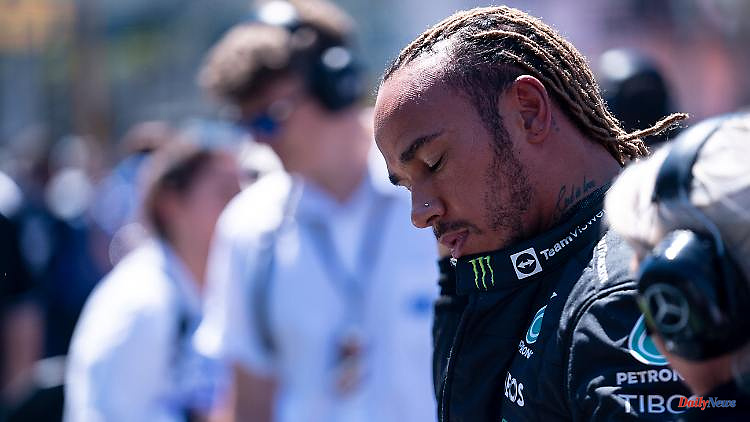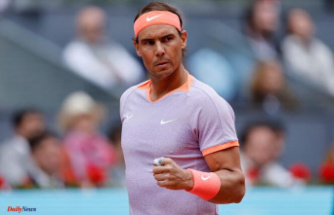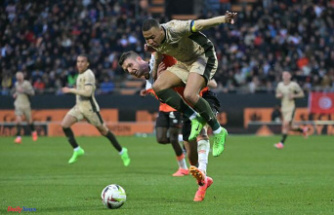Formula 1 drivers are already suffering from pain, and they warn that a serious accident could follow. Lewis Hamilton in particular suffers greatly from the hopping of the cars, and he is even threatened with a forced break. The solution to the problem would be quite simple - but this would come at the expense of speed. And so it is hotly debated.
Lewis Hamilton walked like an old man through the Formula 1 paddock in Baku. Sometimes bent over, sometimes with a stiff gait, he held his back. Now, at 37, the record world champion is the second-oldest driver in the premier motorsport class after Fernando Alonso, but his agony had nothing to do with age. But with excruciating pain that he had contracted on the race track. Hamilton is suffering because of the so-called porpoising that the cars are doing this year - and the Mercedes is particularly bad.
It is conceivable that he will even have to sit out the Grand Prix in Canada next weekend. It is "definitely" possible that Hamilton will be absent, said team boss Toto Wolff. He wasn't just plagued by muscular problems, Hamilton got it worse: "It goes really deep on the spine and that has consequences," said Wolff. The reason is the constant blows that come from the technical problem. At high speed, the cars on the straights are pressed onto the ground until they briefly touch the asphalt and are then pushed up again. The phenomenon resembles the locomotion of porpoises hopping through the water - which is how it was named after the English word for the animal - porpoise. Sounds cute, but the drivers are repeatedly shaken up violently.
"I can't explain the pain you have there, especially on the straights. In the end you just pray that it's over," said Hamilton after finishing fourth. He "bited his teeth" because of the headache and back pain and made it to the finish thanks to the adrenaline. Only massages and acupuncture would help him, he had said after the training. The pain is not going away completely at the moment.
"I saw on the internet that a lot of people were worried about me because it looked so horrible out there. It means so much to me that so many of you send me love," Hamilton reported on Sunday night Instagram. "I'll be honest, it looks awful and feels 100 times worse."
At the same time, he congratulated his teammate George Russell on third place in the post. The 24-year-old had less pain, which is also due to the fact that Hamilton's cars continued to be tweaked on Saturday - in the wrong direction, as Hamilton admitted according to formula1.de: "I had experimental parts on the car and a different rear suspension." It didn't work as hoped. Russell is not satisfied either. "I think it's only a matter of time before there's a major incident," said the Briton, according to motorsport.com. "Many of us can hardly keep the car in a straight line over these bumps."
This was particularly evident in Baku, a circuit notable for its long straights. Hamilton said: "I almost drove into the wall so many times." Even some who previously had fewer problems suffered. For example Carlos Sainz, who, unlike his teammate Charles Leclerc, was “quite annoyed” by his jumping car. "For some reason I had a car, or a floor, that floated and touched the ground a lot more than the other car with the same set-up," said the Ferrari driver. "That cost me my self-confidence, especially in the braking zone." The fact that he then dropped out in the ninth lap of the race due to a hydraulic defect must have only worsened his mood. At least he didn't have to endure the hobbling for 51 laps.
Porpoising is not new for Sainz either: after only two months of the season, he felt the effects on his back and neck, he announced in May. The senior pilot, Alonso, said driving the current cars was "the worst in 20 years". Russell had previously pointed out that in other sports such as soccer and American football, the risk of possible brain damage had long been underestimated and only determined by studies. There must also be such studies for Formula 1.
Alpine pilot Esteban Ocon is also suffering. "You can't prepare for these rashes or train to be ready. It just hurts all over your body," he said, according to motorsport-total.com. "The head gets thrown around quite a bit." On the Baku race track he even thought "I would lose my helmet at the end of the straight" because he was shaken up so badly. At the same time, the tallest driver in the field tried gallows humor: "Hopefully I'll lose a few centimeters!"
A quick change of the problem is not in sight. Alonso believes so too, pointing out that nobody complained about the smooth courses in Melbourne and Jeddah. A rule change "will be very difficult for all teams to agree on," said the Spaniard, "but yeah, I wish they would do something for the young guys - it's okay for me for a few more years."
"I don't think we can drive like this for the next four years," said Russell, who is one of the "young guys". "We just have to talk (about a rule change, editor's note) because everyone is in the same boat." In his capacity as Director of the Drivers' Association GPDA, he has already spoken to the FIA, the world motorsport association. On Friday there was a meeting with race director Niels Wittich. According to racefans.com, his Ferrari competitor Sainz summed it up: "We asked the FIA to look at this, not to listen too much to the teams and instead to listen to us because we said that we've all come to a point , when we can no longer cope with it."
Sebastian Vettel emphasized on Servus TV: "Now of course you can say: Yes, but the car jumps like that, then the setup changes and then it's good. But I don't think we should take it upon ourselves, but maybe with the rules react" He made it clear: "It can't be that we've been driving around like this for four years. At some point it'll bang and bang and then everyone will stand there and say: Yes, we've talked about it before."
The drivers get support from McLaren team boss Andreas Seidl: "The hardness that you see in some cars is brutal for the drivers." He compared the situation to before the season, when the Technical Advisory Committee allowed teams to install underbody braces to better control floor deflection at high speeds. These were initially banned, but were then introduced and have partially alleviated porpoising.
Aston Martin has also found a solution in the meantime, Vettel and Lance Stroll have been sitting in the completely renewed car since Barcelona. "It would have been very difficult here with our old car," said team boss Mike Krack in Baku. And so not all teams are equally affected - and therefore not unanimously for fundamental rule changes. Apparently, the porpoising could have been prevented in advance, according to motorsport.com. Rules were discussed that would have prevented the cars from being so low. However, this change was not supported by enough teams.
And even now the cars are as low as possible, although this promotes porpoising and endangers the health of the drivers. Why? Because otherwise they would lose a lot of performance. So the discussions go on - and the pain. It remains to be seen whether Hamilton will be fit again for the Montreal race. "The solution could be to keep someone in reserve, which we have at every race anyway, so that we can be sure that our cars are driving," said team boss Wolff. The replacement drivers at Mercedes are Belgian Stoffel Vandoorne and Dutchman Nyck de Vries.
But Hamilton doesn't want to give up too quickly, although he begged on the pit radio during the race: "My back is killing me, please let's change something, okay?" On Instagram he wrote that night: "I definitely have to recover a little and work hard with the team before I can take this hurdle in Montreal. But I'm doing better and I'm motivated to continue. See you next week."












